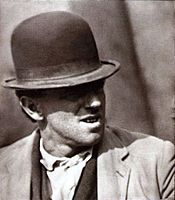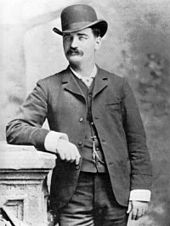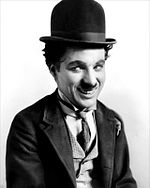- Bowler hat
-
The bowler hat, also known as a coke hat, derby (US), billycock or bombin,[1] is a hard felt hat with a rounded crown originally created in 1849 for the English soldier and politician Edward Coke, the younger brother of the 2nd Earl of Leicester. The bowler hat was popular with the working class during the Victorian era.[2]
Contents
History
The bowler hat was devised in 1849 by the London hatmakers Thomas and William Bowler to fulfil an order placed by the firm of hatters Lock & Co. of St James's.[3] Lock & Co. had been commissioned by a customer to design a close-fitting, low-crowned hat to protect his gamekeepers' heads from low-hanging branches while on horseback. The keepers had previously worn top hats, which were easily knocked off and damaged. Lock & Co. then commissioned the Bowler brothers to solve the problem.[3] While most accounts state that the customer was William Coke, a nephew of the 1st Earl of Leicester, recent research has cast some doubt on this, and it is now believed that it was instead Edward Coke, the younger brother of the 2nd Earl of Leicester.[2]
 Albert Edwin Roberts in 1900.
Albert Edwin Roberts in 1900.
When Coke arrived in London on 17 December 1849 to collect his hat he reportedly placed it on the floor and stamped hard on it twice to test its strength; the hat withstood this test and Coke paid 12 shillings for it.[4] In accordance with Lock & Company's usual practice, the hat was called the "Coke" hat (pronounced “cook”) after the customer who had ordered it. This is most likely why the hat became known as the "Billy Coke" or "Billycock" hat in Norfolk.
The bowler, not the cowboy hat or sombrero, was the most popular hat in the American West, prompting Lucius Beebe to call it "the hat that won the West."[5] Both cowboys and railroad workers preferred the hat because it wouldn't blow off easily in strong wind, or when sticking one's head out the window of a speeding train. It was worn by both lawmen and outlaws, including Bat Masterson, Butch Cassidy, Black Bart, and Billy the Kid.
The bowler, called a bombín in Spanish, has been worn by Quechua and Aymara women since the 1920s, when it was introduced to Bolivia by British railway workers. For many years, a factory in Italy manufactured the hats for the Bolivian market, but they are now made locally. Another region that appreciates the bowler hat is the Niger Delta area of Nigeria. The men of this region use this hat as a fashion accessory, along with a walking stick. These fashion accessories, which have become a staple part of the regional costume, were introduced by British colonials in the 1900s.[6]
The bowler once defined British civil servants and bankers.[3] The bowler is commonly worn by participants in the Saddle Seat disciplines of horse-back riding in the United States. It is also worn for foxhunting. Now the hat is rarely seen on urban professionals, but vintage hats are occasionally worn by members of youth subcultures.
In popular culture
- A bowler hat is the logo of British bank Bradford & Bingley.[7]
- David Tomlinson wore a bowler in Mary Poppins as the character Mr. Banks, a London banker.[8]
- Comedic actors Stan Laurel and Oliver Hardy were well-known for their bowler hats.[3]
- Charlie Chaplin's character "The Tramp" almost always wore a bowler.[3]
- Bowler hats have been worn by world leaders, including the Italian Prime Minister Benito Mussolini and British Prime Minister Winston Churchill.[3]
- In the movie Goldfinger, Auric Goldfinger's manservant Oddjob uses a razor-edged bowler hat as a weapon.[3]
- The novel - The Unbearable Lightness of Being (by Milan Kundera): The bowler hat plays a significant role in the affair between Tomas and Sabina
- In the 2009 film Sherlock Holmes, Robert Downey Junior wore a bowler as the title character.[3]
- In the long-running TV show "Our Gang," Stymie wears a bowler hat, usually with a chinstrap.[9]
References
- ^ Hat Glossary
- ^ a b "The history of the Bowler hat at Holkham" (PDF). Coke Estates Ltd.. http://www.holkham.co.uk/downloads/TheBowlerHat.pdf.
- ^ a b c d e f g h Bowler hat makes a comeback Telegraph. Retrieved 25 September 2011
- ^ Swinnerton, Jo (2005). The History of Britain Companion. Robson. p. 42. ISBN 1861059140.
- ^ The Hat That Won the West, http://news.google.com/newspapers?nid=336&dat=19571026&id=xQQpAAAAIBAJ&sjid=PkgDAAAAIBAJ&pg=7036,5636283, retrieved 2010-02-10
- ^ Eigo, Tim. "Bolivian Americans". Countries and Their Cultures. http://www.everyculture.com/multi/A-Br/Bolivian-Americans.html. Retrieved 2008-08-13.
- ^ Who'll get custody of Bradford and Bingley's bowler hat? BBC News. Retrieved 25 September 2011
- ^ Mary Poppins - a tale for our times BBC News. Retrieved 25 September 2011
- ^ Little Rascals Episode Guide - Early Intermediate
Further reading
- Fred Miller Robinson, The Man in the Bowler Hat: His History and Iconography (Chapel Hill and London: The University of North Carolina Press, 1993).
- "Whatever Became of the Derby Hat?" Lucius Beebe, Gourmet, May 1966.
External links
Categories:- Hats
- History of clothing (Western fashion)
- History of fashion
- English clothing
- 1850 introductions
- Rider apparel
- 1880s fashion
- 1890s fashion
- 1900s fashion
- 1910s fashion
- 1920s fashion
- 1930s fashion
- 1940s fashion
Wikimedia Foundation. 2010.




